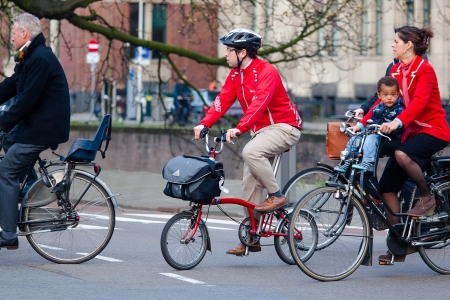Below you will find the list of references that are used in this fact sheet; all sources can be consulted or retrieved. Via Publicaties you can find more literature on the subject of road safety.
[1]. Bliven, E., Rouhier, A., Tsai, S., Willinger, R., et al. (2019). Evaluation of a novel bicycle helmet concept in oblique impact testing. In: Accident Analysis & Prevention, vol. 124, p. 58-65.
[2]. Stigson, H. & Kullgren, A. (2015). Folksam’s Bicycle Helmet Test 2015. Folksam.
[3]. Ellena, T., Subic, A., Mustafa, H. & Pang, T.Y. (2016). The Helmet Fit Index – An intelligent tool for fit assessment and design customisation. In: Applied Ergonomics, vol. 55, p. 194-207.
[4]. Romanow, N.R., Hagel, B.E., Williamson, J. & Rowe, B.H. (2014). Cyclist head and facial injury risk in relation to helmet fit: a case-control study. In: Chronic diseases and injuries in Canada, vol. 34, nr. 1, p. 1-7.
[5]. RWS (2023). Vervolgmeting apparatuurgebruik & 0-meting helmdracht fietsers - meting 2023. Rijkswaterstaat, Den Haag.
[6]. Achermann Stürmer, Y., Berbatovci, H. & Buttler, I. (2020). Cyclists. ESRA2 Thematic report Nr. 11. ESRA project (E-Survey of Road users’ Attitudes). Swiss Council for Accident Prevention, Bern, Switzerland.
[7]. Wijlhuizen, G.J. & Gent, P. van (2014). Race- en toerfietsen: mogelijkheden voor meer veiligheid. Vragenlijststudie en expertbeoordeling [Racing and touring bicycles: opportunities for greater safety. Questionnaire study and expert assessment]. R-2014-20A [Summary in English]. SWOV, Den Haag.
[8]. Schagen, I.N.L.G. van (2023). De fietshelm en manieren om vrijwillig gebruik te stimuleren. Een inventarisatie van ervaringen in Nederland en elders [Bicycle helmets and ways to encourage voluntary use. An inventory of experiences in the Netherlands and elsewhere]. R-2023-7 [Summary in English]. SWOV, Den Haag.
[9]. Esmaeilikia, M., Grzebieta, R. & Olivier, J. (2018). A systematic review of bicycle helmet laws enacted worldwide. In: Journal of the Australasian College of Road Safety, vol. 29, nr. 3, p. 30-38.
[10]. Aarts, L., Eenink, R. & Weijermars, W. (2014). Opschakelen naar meer verkeersveiligheid; naar maximale verkeersveiligheid voor en door iedereen. R-2014-37. SWOV, Den Haag.
[11]. Boele, M., Panneman, M., Adriaensens, L., Goldenbeld, C., et al. (2016). Fietshelmcampagne ‘Coole kop, helm op!’ in Zeeland. Evaluatie van de effecten. SWOV/VeiligheidNL, Den Haag/Amsterdam.
[12]. Goldenbeld, C., Boele, M.J. & Commandeur, J.J.F. (2016). Evaluatie fietshelmcampagne 'Coole kop, helm op!' in Zeeland. Effecten op helmgebruik en factoren van invloed [Evaluation bicycle helmet campaign 'Wanna look cool, wear a helmet!' in the Province of Zeeland in the Netherlands; Effects on helmet use and influential factors]. R-2016-8 [Summary in English]. SWOV, Den Haag.
[13]. Karkhaneh, M., Kalenga, J.C., Hagel, B.E. & Rowe, B.H. (2006). Effectiveness of bicycle helmet legislation to increase helmet use: a systematic review. In: Injury Prevention, vol. 12, nr. 2, p. 76-82.
[14]. Finnoff, J.T., Laskowski, E.R., Altman, K.L. & Diehl, N.N. (2001). Barriers to bicycle helmet use. In: Pediatrics, vol. 108, nr. 1, p. e4.
[15]. Berg, P. & Westerling, R. (2001). Bicycle helmet use among schoolchildren--the influence of parental involvement and children's attitudes. In: Injury prevention: journal of the International Society for Child and Adolescent Injury Prevention, vol. 7, nr. 3, p. 218-222.
[16]. Lajunen, T. (2016). Barriers and facilitators of bicycle helmet use among children and their parents. In: Transportation Research Part F: Traffic Psychology and Behaviour, vol. 41, p. 294-301.
[17]. Ross, T.P., Ross, L.T., Rahman, A. & Cataldo, S. (2010). The bicycle helmet attitudes scale: using the health belief model to predict helmet use among undergraduates. In: Journal of American College Health, vol. 59, nr. 1, p. 29-36.
[18]. Seijts, G.H.P., Kok, G., Bouter, L.M. & Klip, H.A.J. (1995). Barriers to wearing bicycle safety helmets in the Netherlands. In: Archives of Pediatrics & Adolescent Medicine, vol. 149, nr. 2, p. 174-180.
[19]. Høye, A. (2018). Bicycle helmets – To wear or not to wear? A meta-analyses of the effects of bicycle helmets on injuries. In: Accident Analysis & Prevention, vol. 117, p. 85-97.
[20]. Olivier, J. & Creighton, P. (2016). Bicycle injuries and helmet use: a systematic review and meta-analysis. In: International Journal of Epidemiology, vol. 46, nr. 1, p. 278–292.
[21]. Guerre, L.E.V.M. de, Sadiqi, S., Leenen, L.P.H., Oner, C.F., et al. (2020). Injuries related to bicycle accidents: an epidemiological study in The Netherlands. In: European Journal of Trauma and Emergency Surgery, vol. 46, p. 413-418.
[22]. Zeegers, T. (2015). Overestimation of the effectiveness of the bicycle helmet by the use of odds ratios. Paper presented at International Cycling Safety Conference 15-16 September 2015, Hanover.
[23]. Olivier, J. & Radun, I. (2017). Bicycle helmet effectiveness is not overstated. In: Traffic Injury Prevention, vol. 18, nr. 7, p. 755-760.
[24]. Cripton, P.A., Dressler, D.M., Stuart, C.A., Dennison, C.R., et al. (2014). Bicycle helmets are highly effective at preventing head injury during head impact: Head-form accelerations and injury criteria for helmeted and unhelmeted impacts. In: Accident Analysis & Prevention, vol. 70, p. 1-7.
[25]. Connor, T.A., Meng, S., Zouzias, D., Burek, R., et al. (2015). Current standards for sports and automotive helmets: a review. HEADS-ITN.
[26]. Fahlstedt, M., Halldin, P. & Kleiven, S. (2016). The protective effect of a helmet in three bicycle accidents - A finite element study. In: Accident Analysis & Prevention, vol. 91, p. 135-143.
[27]. McNally, D.S. & Whitehead, S. (2013). A computational simulation study of the influence of helmet wearing on head injury risk in adult cyclists. In: Accident Analysis & Prevention, vol. 60, p. 15-23.
[28]. Verschueren, P. (2009). Biomechanical analysis of head injuries related to bicycle accidents and a new bicycle helmet concept. Dissertation KU Leuven, Leuven.
[29]. Dennis, J., Ramsay, T., Turgeon, A.F. & Zarychanski, R. (2013). Helmet legislation and admissions to hospital for cycling related head injuries in Canadian provinces and territories: interrupted time series analysis. In: BMJ : British Medical Journal, vol. 346, p. f2674.
[30]. Bonander, C., Nilson, F. & Andersson, R. (2014). The effect of the Swedish bicycle helmet law for children: An interrupted time series study. In: Journal of Safety Research, vol. 51, p. 15-22.
[31]. Olivier, J., Boufous, S. & Grzebieta, R. (2019). The impact of bicycle helmet legislation on cycling fatalities in Australia. In: International journal of epidemiology, vol. ePub.
[32]. Craen, S. de, Bijleveld, F.D., Bos, N.M., Broek, B. van den, et al. (2022). Halvering verkeersslachtoffers in 2030? Doorrekening van aanvullende maatregelen [A 50% reduction in road casualties by 2030? Calculating the effect of additional measures]. R-2022-8A [Summary in English]. SWOV, Den Haag.
[33]. Adams, J. & Hillman, M. (2001). The risk compensation theory and bicycle helmets. In: Injury prevention: journal of the International Society for Child and Adolescent Injury Prevention, vol. 7, nr. 2, p. 89-91.
[34]. Esmaeilikia, M., Radun, I., Grzebieta, R. & Olivier, J. (2019). Bicycle helmets and risky behaviour: A systematic review. In: Transportation Research Part F: Traffic Psychology and Behaviour, vol. 60, p. 299-310.
[35]. Høye, A. (2018). Recommend or mandate? A systematic review and meta-analysis of the effects of mandatory bicycle helmet legislation. In: Accident Analysis & Prevention, vol. 120, p. 239-249.
[36]. Walker, I. (2007). Drivers overtaking bicyclists: Objective data on the effects of riding position, helmet use, vehicle type and apparent gender. In: Accident Analysis & Prevention, vol. 39, nr. 2, p. 417-425.
[37]. Olivier, J. & Walter, S.R. (2013). Bicycle helmet wearing is not associated with close motor vehicle passing: A re-analysis of Walker, 2007. In: PLoS ONE, vol. 8, nr. 9.
[38]. Walker, I. & Robinson, D.L. (2019). Bicycle helmet wearing is associated with closer overtaking by drivers: A response to Olivier and Walter, 2013. In: Accident Analysis & Prevention, vol. 123, p. 107-113.
[39]. Amoros, E., Chiron, M., Martin, J.-L., Thélot, B., et al. (2012). Bicycle helmet wearing and the risk of head, face, and neck injury: a French case–control study based on a road trauma registry. In: Injury Prevention, vol. 18, nr. 1, p. 27.
[40]. Elvik, R. (2013). Corrigendum to: “Publication bias and time-trend bias in meta-analysis of bicycle helmet efficacy: A re-analysis of Attewell, Glase and McFadden, 2001” [Accid. Anal. Prev. 43 (2011) 1245–1251]. In: Accident Analysis & Prevention, vol. 60, p. 245-253.
[41]. Lemon, J. (2018). Changes in participation, demographics and hazard associated with mandatory bicycle helmets in New South Wales, Australia. In: Journal of Transport & Health, vol. 9, p. 195-202.
[42]. Olivier, J., Esmaeilikia, M. & Grzebieta, R. (2018). Bicycle helmets: Systematic reviews on legislation, effects of legislation on cycling exposure, and risk compensation. School of Mathematics and Statistics, Transport and Road Safety Research Centre; UNSW, Sydney.
[43]. Rådet for Sikker Trafik & Epinion (2016). Cyklistundersøgelse [Survey on cyclists]. Radet for Sikker Trafik, Copenhagen.
[44]. Towner, E., Dowswell, T., Burkes, M., Dickinson, H., et al. (2002). Bicycle helmets - a review of their effectiveness: a critical review of the literature. Road Safety Research Report No. 30. Department for Transport, London.
[45]. Lankarani, K.B., Akbari, M., Razzaghi, A., Heydari, S.T., et al. (2023). Mass media campaigns to increase the use of bicycle helmets: A systematic review and meta-analysis. In: Journal of Transport & Health, vol. 30, p. 101616.
[46]. Sølund Ehlers, P. (2022). How the Danish cyclists were convinced to use a bicycle helmet - without a law. Paper presented at FERSI Conference, 6 and 7 october 2022, The Hague.
[49]. Kemler, H.J., Ormel, W., Jonkhoff, L., Klein Wolt, K., et al. (2009). De fietshelm bij kinderen en jongeren. Onderzoek naar de voor- en nadelen. Stichting Consument en Veiligheid, Amsterdam.
[50]. Bourdet, N., Deck, C., Carreira, R.P. & Willinger, R. (2012). Head impact conditions in the case of cyclist falls. In: Proceedings of the Institution of Mechanical Engineers, Part P: Journal of Sports Engineering and Technology, vol. 226, nr. 3-4, p. 282-289.
[51]. Sandberg, M., Tse, K.M., Tan, L.B. & Lee, H.P. (2018). A computational study of the EN 1078 impact test for bicycle helmets using a realistic subject-specific finite element head model. In: Computer Methods in Biomechanics and Biomedical Engineering, vol. 21, nr. 12, p. 684-692.
[52]. Bland, M.L., McNally, C. & Rowson, S. (2018). Differences in impact performance of bicycle helmets during oblique impacts. In: Journal of biomechanical engineering, vol. 140, nr. 9, p. e4040019-e4040019.
[53]. McIntosh, A., Lai, A. & Schilter, E. (2013). Bicycle helmets: head impact dynamics in helmeted and unhelmeted oblique impact tests. In: Traffic Injury Prevention, vol. 14, nr. 5, p. 501-508.
[54]. Mills, N.J. & Gilchrist, A. (2008). Oblique impact testing of bicycle helmets. In: International Journal of Impact Engineering, vol. 35, nr. 9, p. 1075-1086.
[55]. Willinger, R., Deck, C., Halldin, P. & Otte, d. (2014). Towards advanced bicycle helmet test methods. Proceedings of the International Cycling Safety Conference, 18-19 November, Göteborg, Sweden.
[56]. Bland, M.L., Zuby, D.S., Mueller, B.C. & Rowson, S. (2018). Differences in the protective capabilities of bicycle helmets in real-world and standard-specified impact scenarios. In: Traffic Injury Prevention, vol. 19, nr. sup1, p. S158-S163.
[57]. Townsend, E. (2016). The European Union’s role in promoting the safety of cycling: proposals for a safety component in a future EU cycling strategy. European Transport Safety Council Brussels.
[58]. Bogerd, C.P., Annaheim, S., Halldin, P., Houtenbos, M., et al. (2015). HOPE: Helmet Optimization in Europe. The final report of COST Action TU1101. COST Action TU1101 / HOPE collaboration. European Cooperation in Science and Technology COST, Brussels.
[59]. Kurt, M., Laksari, K., Kuo, C., Grant, G.A., et al. (2017). Modeling and optimization of airbag helmets for preventing head injuries in bicycling. In: Annals of Biomedical Engineering, vol. 45, nr. 4, p. 1148-1160.
[60]. Kleiven, S. (2006). Evaluation of head injury criteria using a finite element model validated against experiments on localized brain motion, intracerebral acceleration, and intracranial pressure. In: International Journal of Crashworthiness, vol. 11, nr. 1, p. 65-79.
[61]. Stigson, H., Rizzi, M., Ydenius, A., Engström, E., et al. (2017). Consumer testing of bicycle helmets. Proceedings of the IRCOBI Conference, 13-15 September, Antwerp, Belgium.
[62]. Büth, C.M., Barbour, N. & Abdel-Aty, M. (2023). Effectiveness of bicycle helmets and injury prevention: a systematic review of meta-analyses




